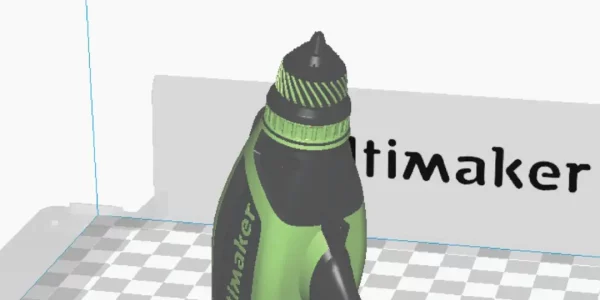How to print with two colors
1. Load the model. To make your dual color print, you’ll need to export two model files, which have been created to fit together. In this tutorial, we will use a famous dual color Ultimaker hand drill model. You can load both parts into Cura by selecting the Open File icon in the top left corner, which will display all the available files. Simply select the file you want to get started. Note, Cura supports the following files: .3mf, .x3d, .stl and .obj. You can also load multiple files simultaneously if you want to speed the process up.
To view some model examples, just browse popular 3D model websites, searching for ‘dual color’ or ‘dual material’. There are several examples online.
2. Set the print cores and materials. You’ll need to check that the print cores and materials are correct (using the sidebar). Print Core 1 should contain a print core AA 0.4 loaded with PLA (your first color). Print Core 2 should contain the same, but with your different color. Cura is loaded with generic materials which don’t represent colors, so to choose a colored material, you’ll need to go to Ultimaker > PLA > Color.
If your Ultimaker 3 is connected to Cura via the network, and loaded with the right print cores and materials, Cura will automatically sync to it.
3. Set print core per model. All loaded objects are set (by default) to be printed using Print Core 1. The material color set per print core relates to the color of the corresponding model. If you want to change the print core, select the model by left clicking on it. Next, select Per Model Settings (left side of the screen), then Print Model with Print Core 2. Please note, the color will automatically match Print Core 2’s color.

If you’ve forgotten to adjust one of the settings, just press CMD / CTRL + click on the model to select it within the group. If your models don’t merge as intended, this means your model files weren’t exported correctly. To correct this, you’ll need to resolve the issue in the design software.



7. Preview your layers. You can view the result of your profile settings in the Layer View. When you’ve got Print Core 1 selected in the sidebar, the model will be highlighted – showing which parts will be printed with each print core. If you switch visible print cores (selecting the print core in the top right), you’ll see which sections will be printed using Print Core 2.

Original blog from Ultimaker: https://ultimaker.com/learn/get-started-with-cura-printing-with-two-colors
